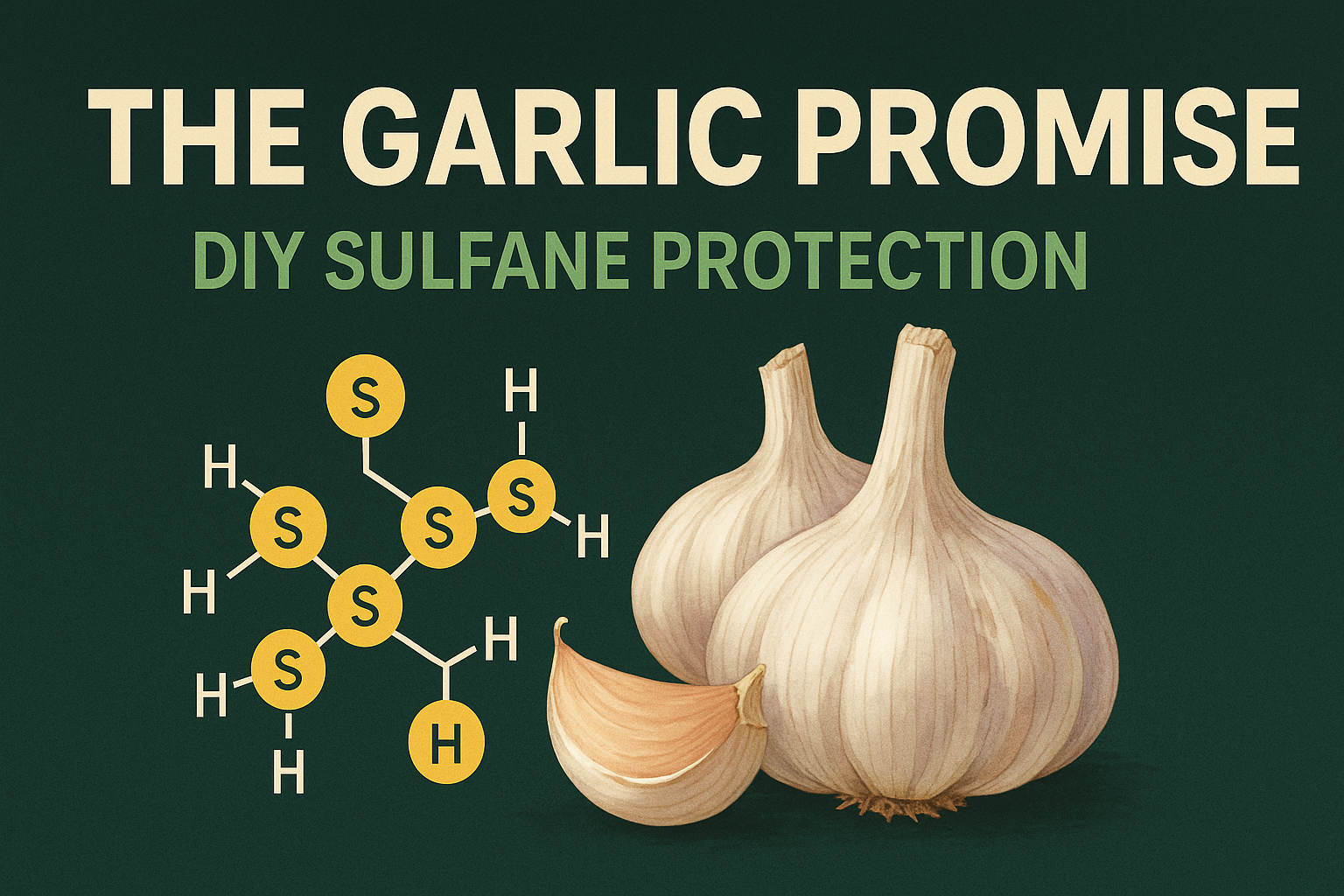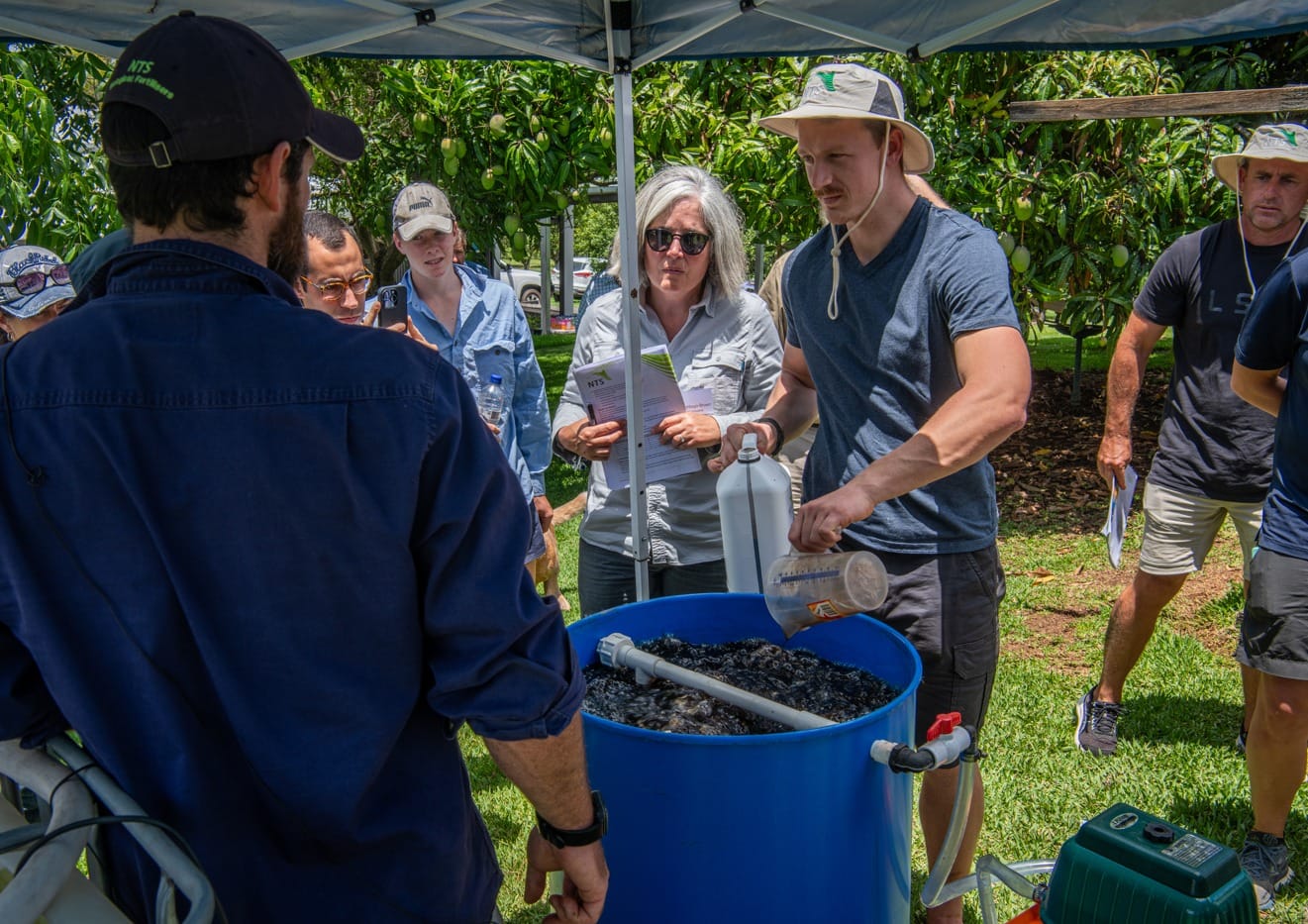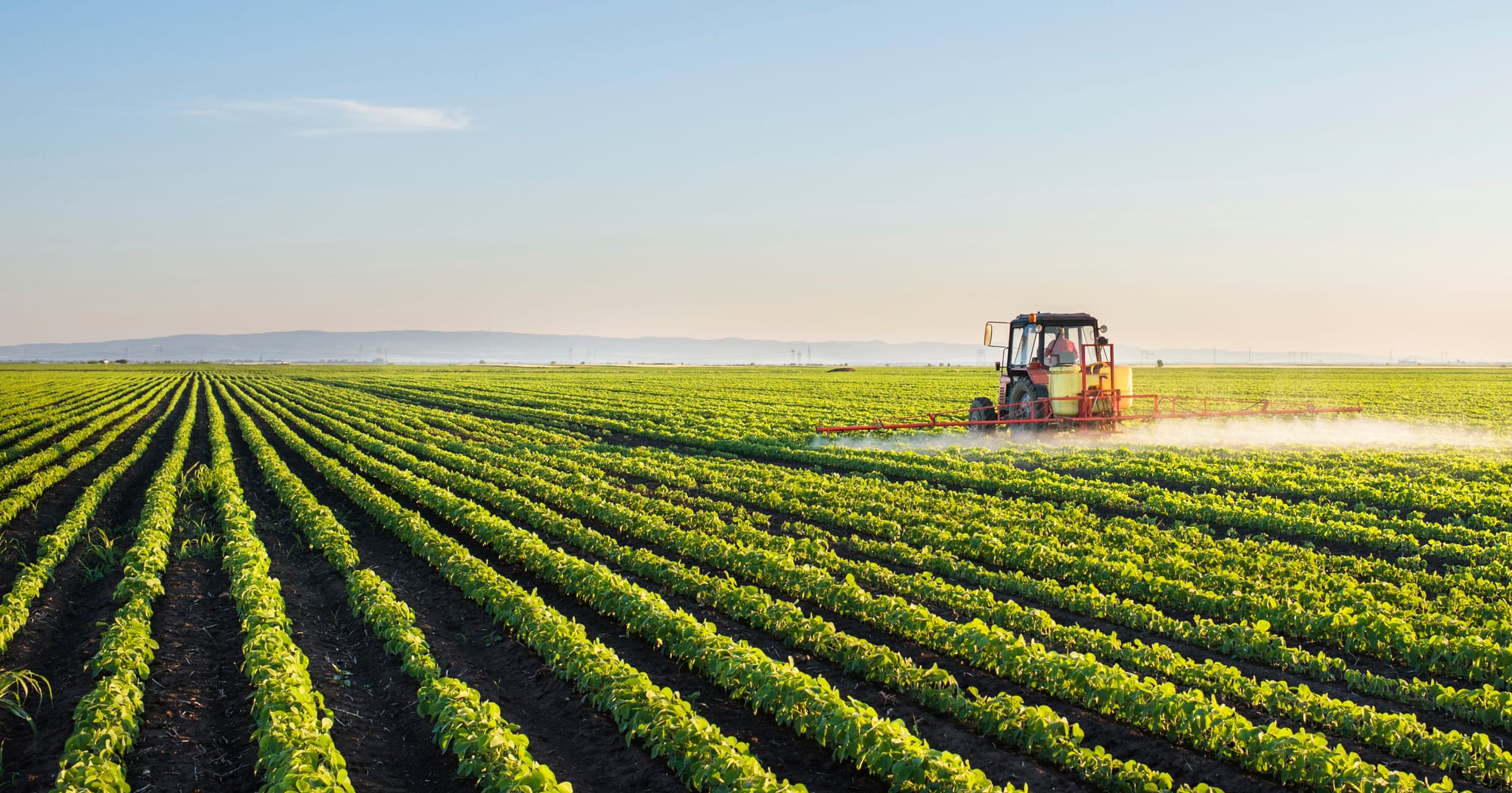🌱The Garlic Promise - DIY Sulfane Protection🌿

When we recognise that almost one-third of the protective chemistry used in agriculture involves a sulphur component, it is not hard to envisage the potential of a natural sulphur-based alternative.
Garlic features a complex suite of sulphur-based molecules, which are attracting major research focus in a world seeking softer, more sustainable options. That research has revealed a broad range of diverse insecticidal, fungicidal and nematocidal properties to date, and these extracts can also kill slugs and snails.

These protective compounds are called sulfanes, and one dominant substance, accounting for 1% of the dry weight of garlic, is called alliin. Alliin resides in the cytosol of the cell and has no particular biological activity until, like a tiger freed from its cage, it is activated. That activation involves bruising or crushing the garlic. This physical trauma releases the alliin to the outer world and also frees an enzyme called alliinase. This enzyme rapidly catalyses the conversion of alliin into allicin. This is the potent sulfur compound that provides many health benefits to humans, but it is quite unstable, and, in case you have ever wondered why aged garlic outperforms regular garlic as a supplement, you are about to find out why.
At room temperature, the unstable allicin slowly decomposes into a range of other organosulfur molecules called DAPS ( diallyl sulfides). It is these polysulfides, present in aged garlic, that are generating all the research excitement. I will soon share a strategy to create your own DIY, multi‑purpose problem solver.
Let’s look at the researched benefits of these sulfane groups called DAPS.
The exciting potential of DAPs
One immediate benefit relates to the complex interaction and diverse interplay associated with these compounds. This is what makes it so difficult for pests to develop resistance, and it represents one of the hidden gains of a more natural approach.
DAPs are also notoriously lipophilic, which means they are attracted to and easily pass through the lipid‑based cell membrane. Thiophilic metals (metals strongly attracted to sulfur) can be better absorbed when combined with DAPs (garlic extracts). There are a few new words here for many of us, so I trust you are all hanging in there because your staying power will be rewarded.
For example, there is some wonderful potential in combining your DIY garlic extracts with thiophilic minerals. These include copper, zinc, iron and molybdenum. There is some immediate fungicidal potential in delivering copper into the cell more effectively, with a substance that is also fungicidal in its own right.
A second major benefit relates to the potential of garlic extracts for insect control. These DAPs have so far been shown to impact various caterpillars, grasshoppers, thrips, beetles, mites, flies and weevils. There is a double whammy here because, in addition to the direct insecticidal impact, garlic is also a good insect repellent.
Like neem oil, garlic is also an antifeedant. There is a good 2016 paper by Chaubey, where significantly less rice weevil damage was reported in the garlic‑treated crop.
Again, a little like neem, garlic DAPs can also inhibit oviposition. That means that the target pest lays fewer eggs, which is always a better outcome.
Nematodes actually cause much more damage to crops than insecticides. In fact, last year their damage amounted to over 160 billion US dollars globally.
In a recent Chinese study, the effect of garlic extract was studied on a nematode called Meloidogyne incognita, which significantly affects major food crops all over the world.
This experiment showed that garlic extract reduced the galling index, the rate of reproduction of eggs and juveniles, and the final population of M. incognita by 73%, 80% and 94% respectively. There was also an obvious increase in yield and profitability associated with this reduced nematode pressure.
As I mentioned earlier, garlic extracts have also been shown to kill slugs and snails. It has been shown here that allicin is the active ingredient that impacts these gastropods.
Farmers currently invest almost 20 billion US dollars in chemical fungicides, and their use is growing at almost 5% each year. Apart from their environmental and human toxicity, there is a major issue involving the speed at which resistance can be developed against these inputs.
For example, there are seventeen commercial fungicides that involve single site bioactives, and the problem is that they all involve the same binding site to disrupt the disease. and the problem is that they all involve the same binding site to disrupt the disease. This simplicity is a calling card for adaptation and associated resistance. DAPs are appealing here because of their multiple modes of action. There is, to date, no reported resistance to DAPs.
Research has revealed the efficacy of garlic extracts in management of some of the world’s most costly diseases, including aspergillus, botrytis, fusarium, pythium and rhizoctonia.
However, there are serious failings in much of the research relevant to the broad‑spectrum protective impact of DAPs. There is often no analysis of the DAP content in the various garlic extracts used for research and, as a result, effective application rates vary wildly.

DIY Pest Management
Extraction of active components is incredibly effective when using lactic acid fermentation as the extraction tool. Here, a super‑productive strategy would involve the combination of crushed garlic with BAM, our beneficial anaerobe product. This is easily achieved in a 1000‑litre shuttle with molasses, and the brewing process would involve a minimum of six weeks. When employing this strategy, you can extract and stabilise the active DAP components while also introducing the multiple benefits of BAM.
Remember that the powerhouse active called allicin decomposes into much more stable and active DAPs. BAM would speed that decomposition and stabilise the end product. BAM stays stable for over two years.
It would be very much a “suck it and see” proposition in terms of determining effective application rates of the end product. However, it is pretty much a no‑lose proposition. There is no gamble because garlic has more to offer than DAPs. Garlic extract is a highly nutritious extract in its own right. It contains a large number of important enzymes and more than 200 biochemical compounds, including antioxidants and vitamins.
In one Indian study, involving faba beans on sandy soil, there was a marked increase in yield and crop quality from applications of garlic extract at 5%. Data clearly showed that foliar treatments caused marked increases in photosynthetic pigments, indole acetic acid, phenolics, carbohydrate constituents, free amino acids and proline contents of the faba beans. I’m now getting excited about my plans for value‑adding any damaged or substandard garlic in this season’s crop.
Recipe for a DIY Garlic Multifunction Marvel
- Add 100 kg of freshly crushed garlic to a 1000‑litre shuttle with 50 litres of molasses and 100 litres of the BAM mother concentrate.
- Now, top up the tank with 750 litres of water.
- Drill a 12 ml hole in the top of the shuttle (not through the lid) and insert a 1‑metre length of garden hose into the airspace at the top of the shuttle. If you fill the shuttle to the 1000‑litre mark, there is typically 100 mL of air space. Seal the entry point with a little silica sealant.
- Attach a 2‑litre plastic soft drink bottle, filled with water, to the metal frame of the shuttle, about two rungs from the top. This capless bottle is filled with water prior to inserting the other end of the garden hose down to the bottom of the bottle. The bottle bubbles as the brew ferments. You have effectively created a one‑way valve here, just like brewing beer. The CO₂ produced as the organisms do their thing has a release pathway, but unwanted oxygen cannot enter.
- The full garlic fermentation will take a minimum of 4 weeks, and you can monitor pH to chart your progress. When the pH drops to 3.5, the fermentation is complete.
Note: It’s always a good idea to position the tank on a couple of concrete blocks, so that a 20‑litre bucket can be positioned under the lower tap.
Application rates
It is possible to burn crops if this garlic ferment is too concentrated as a foliar, but it’s not an issue when fertigating or liquid‑injecting the brew.
Soil drench: 5–10 L/ha (diluted 1:50 to 1:100).
Foliar spray: 200–500 mL/100 L water (always test first).
Nematicidal/insecticidal drench: 1–2% solution around roots.

DIY Aged Garlic Extracts (AGEs) for your health
In our genuinely holistic Nutrition Farming approach, I will also share tips for my fellow farmers to live longer, happier, healthier lives. Fresh garlic is a wonderfully productive supplement when bruised, oxidised for 11 minutes, and consumed at the rate of two cloves per day.
Eating two fresh cloves of garlic daily can:
- Support heart and blood vessel health.
- Boost immunity.
- Protect against microbes, including Candida.
- Reduce inflammation and oxidative stress.
- Improve blood sugar balance.
- Note: Large amounts of raw garlic can cause digestive upset, reflux, or strong body odour in some people, and it may thin the blood (a caution if you are already on anticoagulants).
When garlic is aged, the chemistry changes and the benefits are significantly amplified. There is also much less risk of digestive upset that some may experience when supplementing with raw cloves.
Here are two ways you can make your own aged garlic extract (AGE). One involves extraction with ethanol via the use of diluted vodka, and the other involves lactofermentation.
How to Use Vodka to Produce an Aged Garlic Extract (AGE )
- Garlic prep: Crush or mince garlic (to activate alliinase and form allicin).
- Solvent: Mix vodka with an equal part of chlorine‑free water (gives ~18–20% ethanol).
- Ratio: About 100 g garlic per 1 L ethanol-water mix (1:10 w/v).
- Fermentation/aging: Place in a glass or stainless container, airtight, away from light.
- Time: Age for 3–12 months, stirring occasionally. Over time, allicin breaks down into diallyl sulfides (DAPs) + S-allyl cysteine (SAC) — both of which offer significant protective benefits.
- After aging: Filter solids and store liquid in dark bottles.
This potent supplement is dosed at two teaspoons a day to address hypertension, fight free radicals and to counter candida while also reducing inflammation.

Discover Synbiotics
I recently discovered this technique to lactoferment and amplify the benefits of functional food. It is based upon the gut health concept of synbiotics. This involves the combination of a prebiotic and a probiotic.
We have had unparalleled feedback with the combination of our probiotic, BioBubble and our yacon‑based juice, Sublime Health. Yacon is the most powerful of all prebiotics and, in our Sublime Health formula, it is combined with therapeutic rates of organic ginger and turmeric, along with apple and lemon juice.
Customers call it “life-changing” when trialling a one‑litre bottle of Sublime Health combined with a 500 mL bottle of BioBubble. This ten‑day course involves 100 mL of Sublime Health combined with 50 mL of BioBubble.
This combination can also be used to lactoferment, and here is what you might try. I have not yet experimented with fermenting garlic, as this is a new concep,t and it is off‑season for garlic. The only garlic available at present is from China, and that product is definitely not suitable for AGEs. Here, we are trying to convert allicin into protective DAPs. There is very little allicin remaining in Chinese garlic because they irradiate it to stop premature sprouting and extend shelf life. This kills the enzyme called allinase, which is a critical component in the formation of allicin.
Synbiotic fermentation of garlic
Ingredients:
- Peeled, bruised garlic cloves.
- One litre bottle of Sublime Health from NTS
- One 500 ml bottle of BioBubble from NTS
- A 250-gram pack of Nutri-Salt from NTS
Process:
- Select the number of garlic cloves you would like to treat and bruise them with a meat tenderiser before coating them liberally with Nutri‑Salt.
- Now add a sufficient 50/50 mix of BioBubble and Sublime Health to completely immerse the bruised and salted garlic cloves.
- This should ideally be done in a clay fermenting pot or a glass jar fitted with a one‑way valve.
- Ferment at room temperature (20–25 °C).
- Fermentation is usually 2 weeks. By then, pH should be 3.5. The garlic flavour mellows, and bioactive compounds are now stable.
- Store in the fridge (4 °C). Shelf life is several months if kept submerged and acidic.
- Both the fermented garlic and the remaining liquid should be consumed.
Application rates
- Fermented cloves: 1–3 cloves/day, eaten directly, in salads, or blended.
- Fermented garlic liquid: 1–2 teaspoons/day diluted in water/juice, or as a condiment base.
I trust you are all now suitably excited about the use of fermented garlic for the health of both your family and your farm.
Springtime is here, and may your plantings flourish.
P.S. The ad below covers the synbiotic potential of Sublime Health and Biobubble.




To order or learn more, call NTS on (07) 5472 9900 or email sales@nutri-tech.com.au.
Certificate in Nutrition Farming

Our next iconic, five-day Certificate in Nutrition Farming® course is scheduled for Monday 27th - 31st October 2025.
Our last course was attended by growers and consultants from six countries. It was a wonderful learning opportunity where attendees enjoyed a wealth of education and inspiration from both our presenters and their fellow attendees. We only accept 40 bookings for these courses, so please register if you would like to attend.

